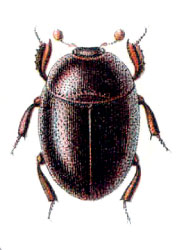Bacaniini
Michael S. Caterino- Triballodes
- Antongilus
- Geocolus
- Bacanius (non-monophyletic)
- Chaetobacanius
- Abraeomorphus
Introduction
Bacaniini, along with the possibly related Abraeinae, have been informally lumped together as ‘microhisteridae’. All of the genera exhibit very small (most < 2mm) body size. Together the genera listed contain slightly over 100 described species. Bacanius, by far the largest genus, is cosmopolitan. The others are more restricted. The species are poorly known taxonomically and biologically. Many hundreds remain to be described from both New and Old World tropics.
Characteristics
Bacaniini are readily recognized among histerids by the reduction and concealment of the propygidium under the elytra. All known species are strongly convex and ovoid, many nearly spherical.
Discussion of Phylogenetic Relationships
Relationships among the genera of Bacaniini have not been examined. It is highly likely that Bacanius itself is paraphyletic, possibly with respect to all the remaining bacaniine genera.
References
Caterino, M. S., and A. P. Vogler. 2002. The phylogeny of the Histeroidea. Cladistics 18(4):394-415.
Slipinski, S. A., and S. Mazur. 1999. Epuraeosoma, a new genus of Histerinae and phylogeny of the family Histeridae. Annales Zoologici (Warszawa) 49:209-230.
Title Illustrations

| Scientific Name | Bacanius rhombophorus |
|---|---|
| Reference | Reitter, Edmund. 1908. Die Käfer des Deutschen Reiches. Band 2. Fauna Germanica. K. G. Lutz Verlag, Stuttgart. |
| Source Collection | BioLib Online Library of Biological Books |
About This Page

Santa Barbara Museum of Natural History, Santa Barbara, California, USA
Page copyright © 2002
 Page: Tree of Life
Bacaniini.
Authored by
Michael S. Caterino.
The TEXT of this page is licensed under the
Creative Commons Attribution License - Version 3.0. Note that images and other media
featured on this page are each governed by their own license, and they may or may not be available
for reuse. Click on an image or a media link to access the media data window, which provides the
relevant licensing information. For the general terms and conditions of ToL material reuse and
redistribution, please see the Tree of Life Copyright
Policies.
Page: Tree of Life
Bacaniini.
Authored by
Michael S. Caterino.
The TEXT of this page is licensed under the
Creative Commons Attribution License - Version 3.0. Note that images and other media
featured on this page are each governed by their own license, and they may or may not be available
for reuse. Click on an image or a media link to access the media data window, which provides the
relevant licensing information. For the general terms and conditions of ToL material reuse and
redistribution, please see the Tree of Life Copyright
Policies.
- First online 07 March 2002
Citing this page:
Caterino, Michael S. 2002. Bacaniini. Version 07 March 2002 (under construction). http://tolweb.org/Bacaniini/9384/2002.03.07 in The Tree of Life Web Project, http://tolweb.org/








 Go to quick links
Go to quick search
Go to navigation for this section of the ToL site
Go to detailed links for the ToL site
Go to quick links
Go to quick search
Go to navigation for this section of the ToL site
Go to detailed links for the ToL site